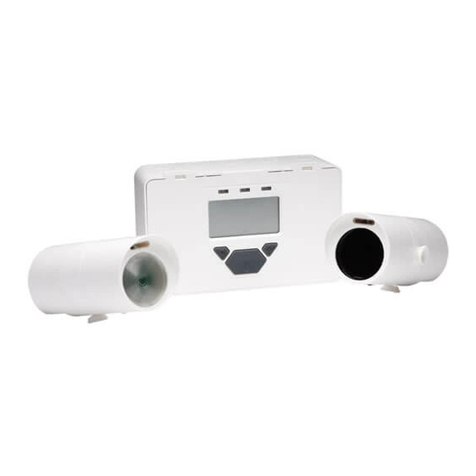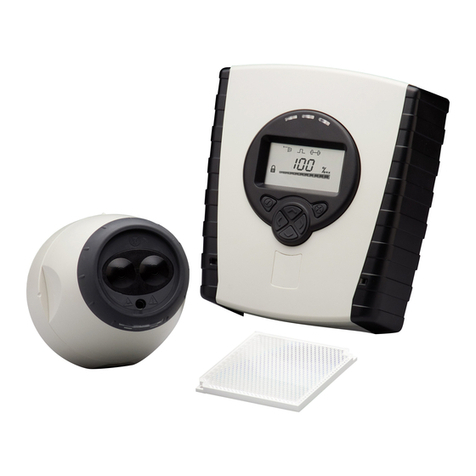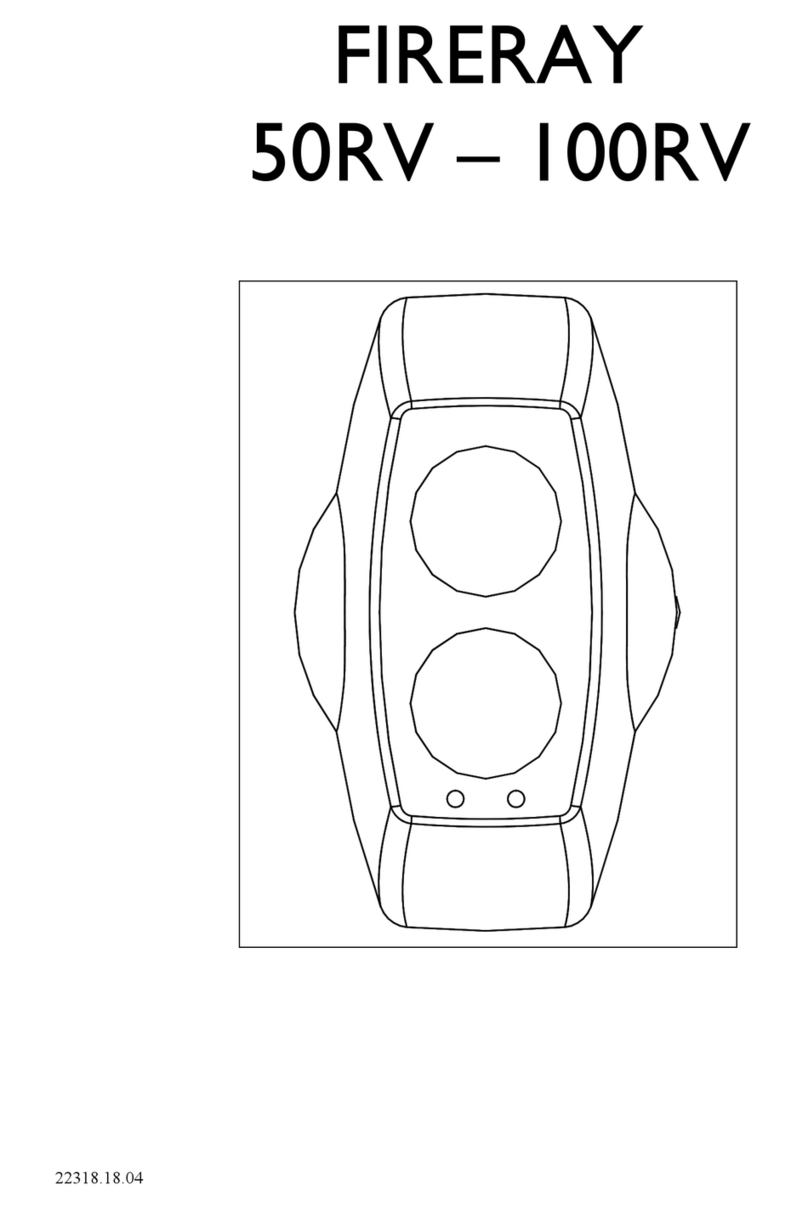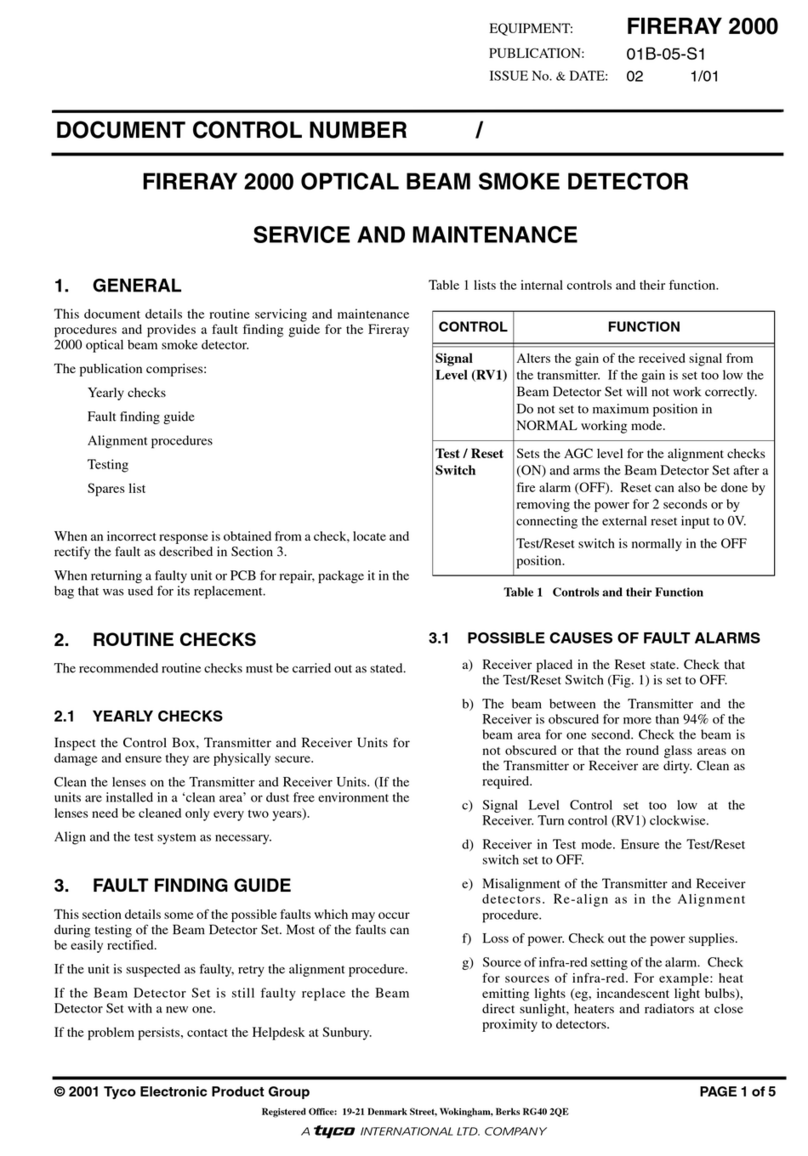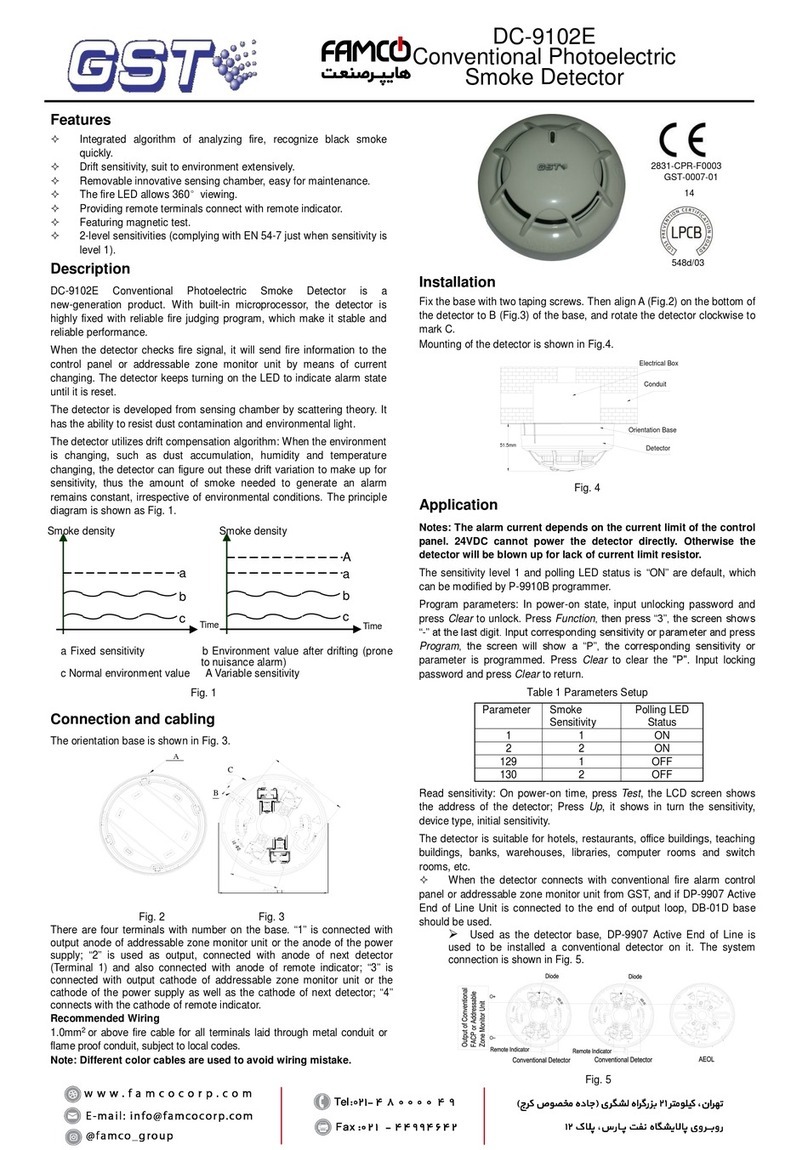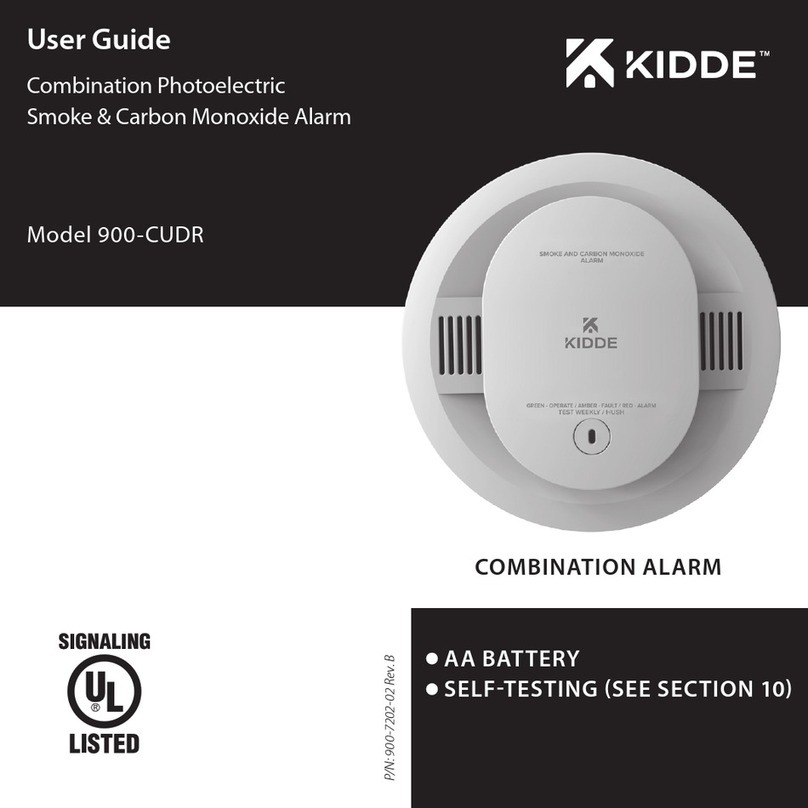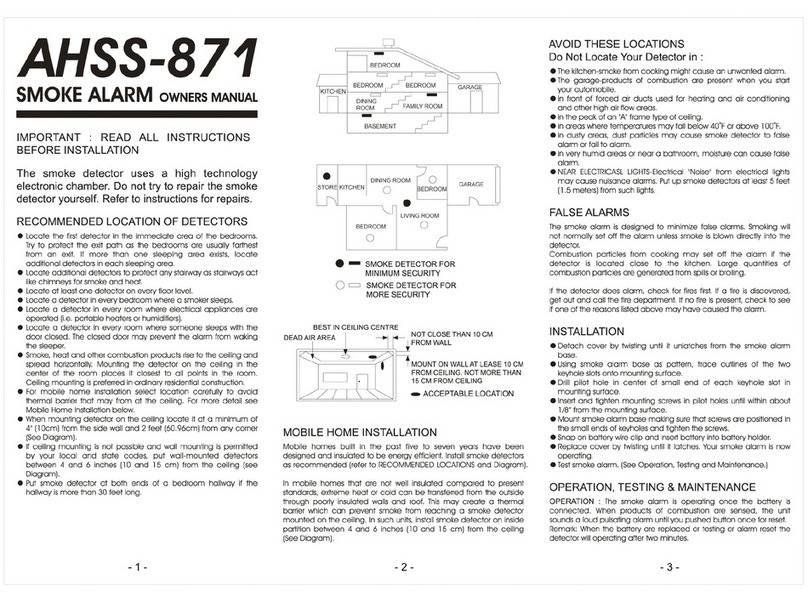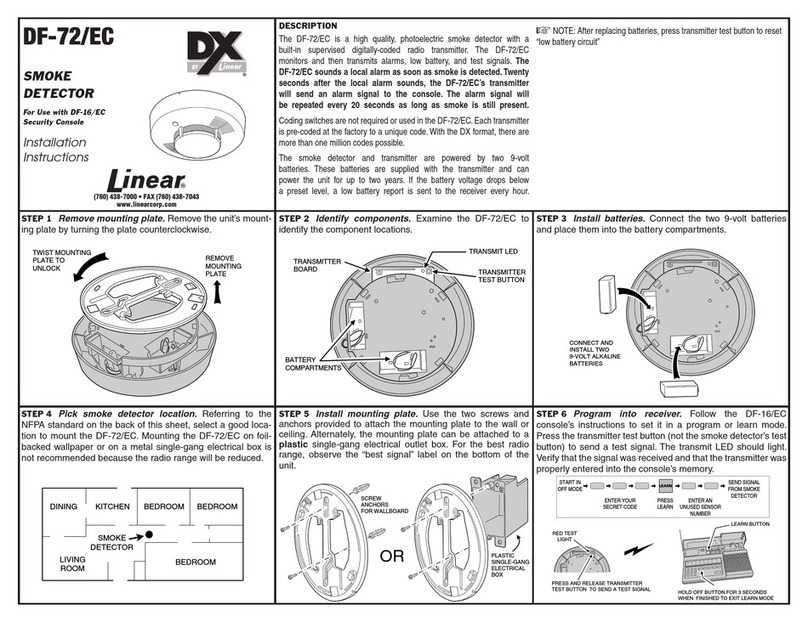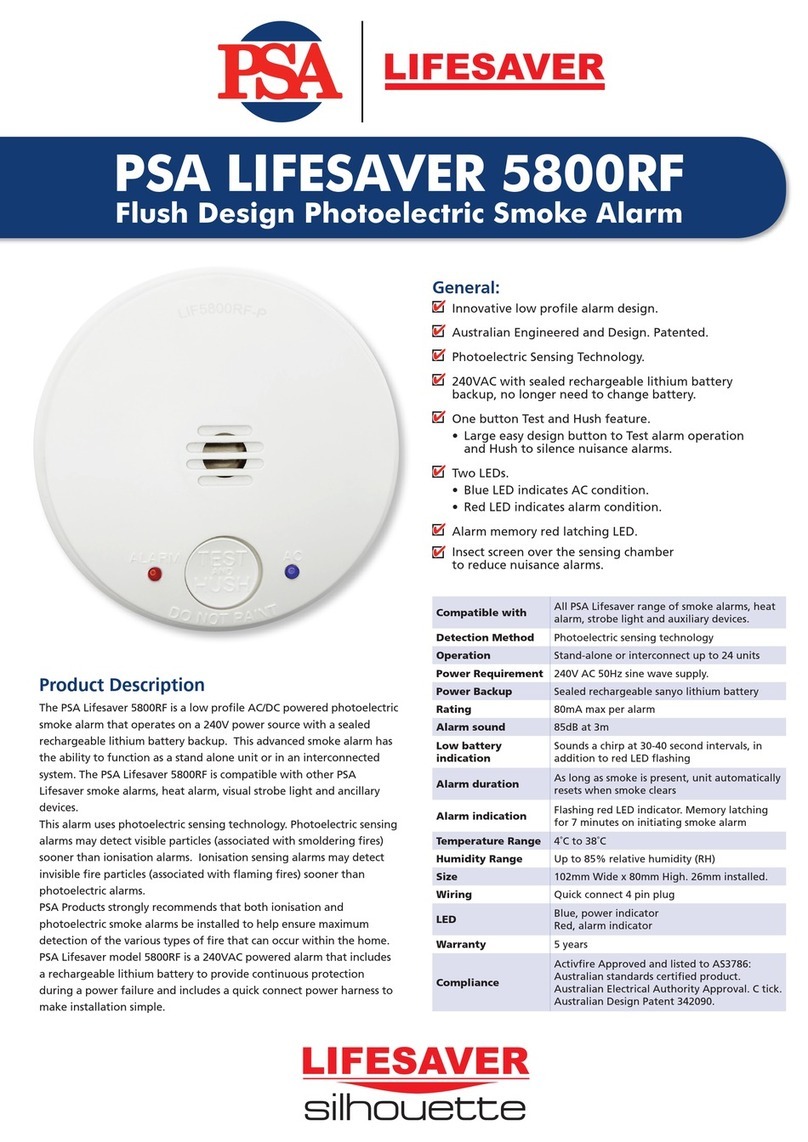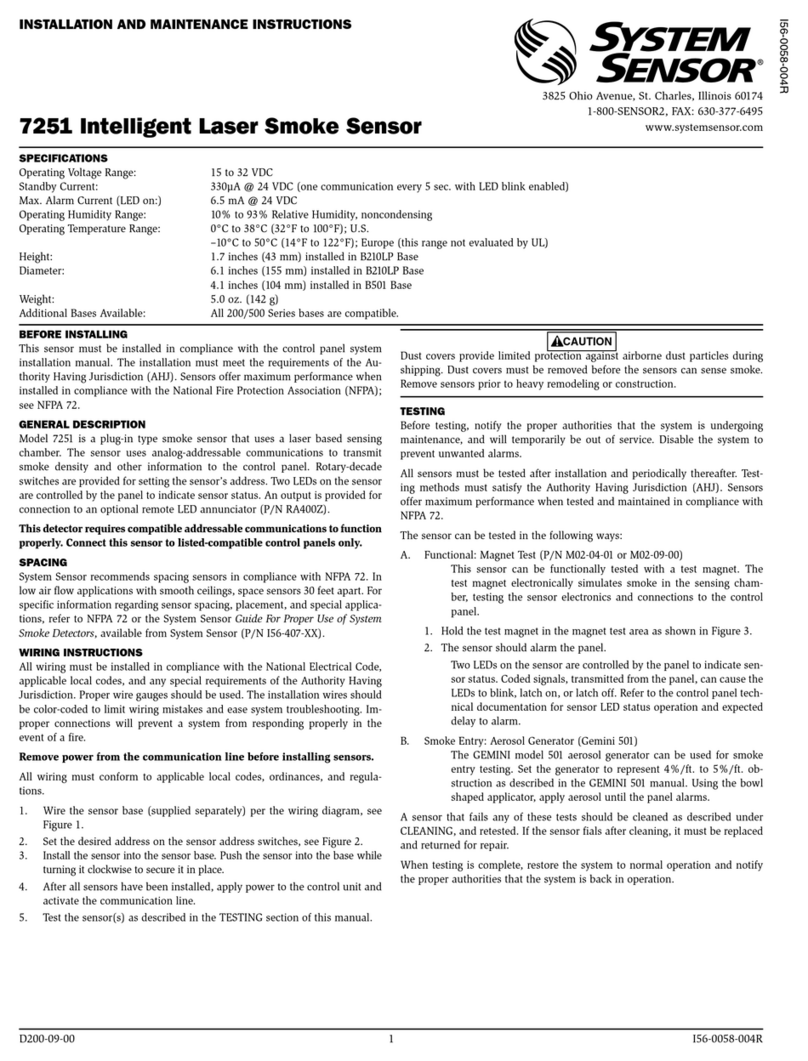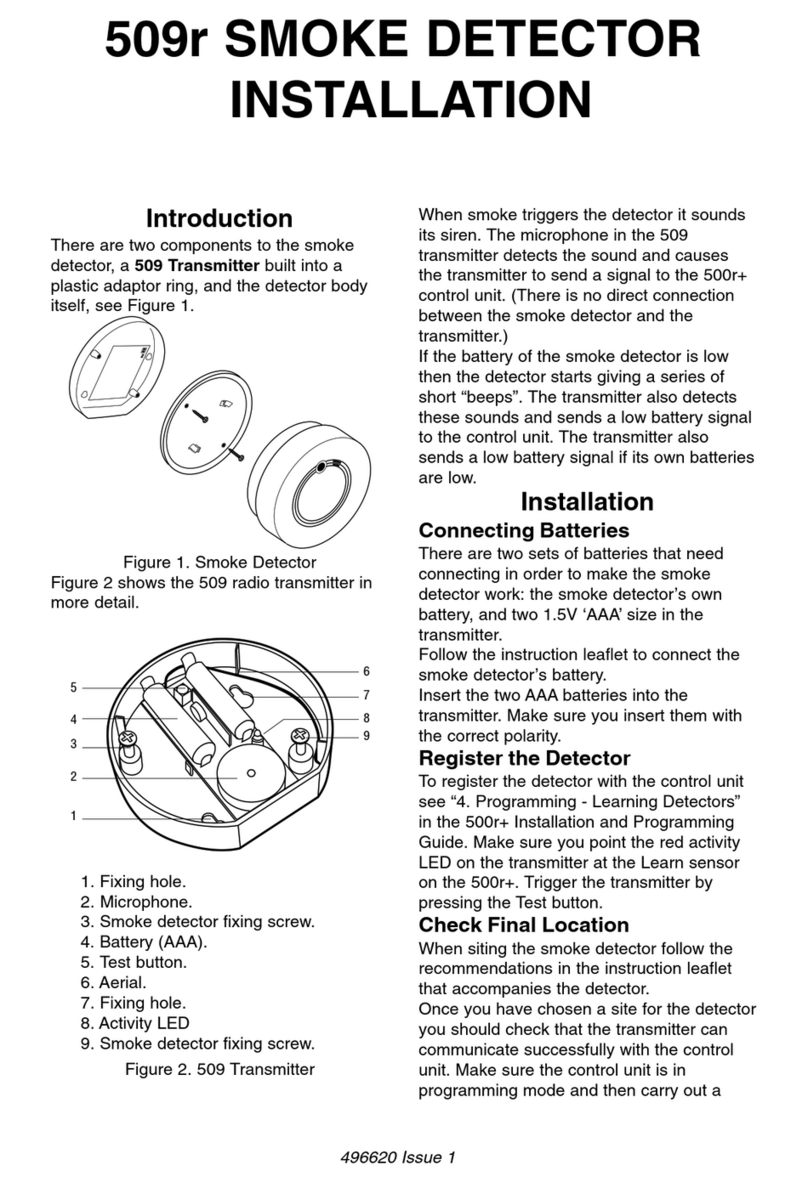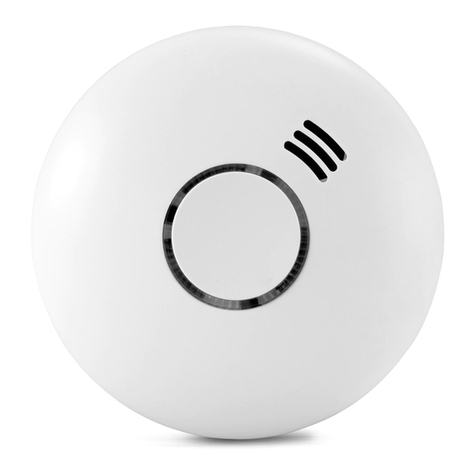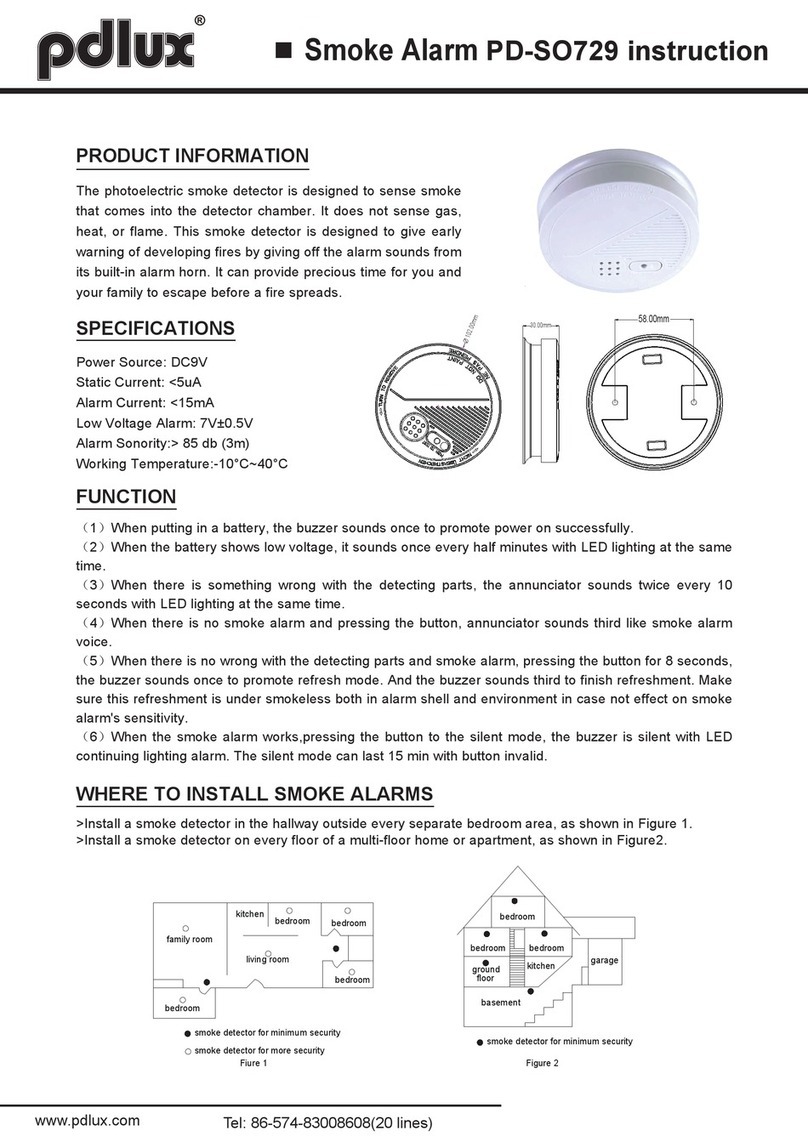Fireray FD2705R User manual

FEATURES
• Microprocessor
controlled
• Range 5 – 50 Metres
• Range 50 – 100 Metres
• Unique simple alignment
• Loop powered
• Selectable alarm
thresholds
• Low current
consumption
•
Automatic contamination
compensation
22318.26.01
Loop Powered
Analogue Addressable
www.acornfiresecurity.com
www.acornfiresecurity.com

22318.26.01
1. System Description.
Fireray FD2705R/FD2710R Detector comprises a Transmitter and Receiver contained within one enclosure.
The Detector installs to the building fabric between 0.3 and 0.6 metres from the ceiling.
The Transmitter emits an invisible infrared light beam that is reflected via a prism(s) mounted directly opposite
and with a clear line of sight. The reflected infrared light is detected by the Receiver and analysed.
The Detector has maximum lateral detection of 7.5 metres either side of the beam.
2. System Operation.
Smoke in the beam path will reduce the received infrared light proportionally to the density of the smoke. The
Detector analyses this attenuation or obscuration of light and acts accordingly.
Alarm thresholds of 25%, 35%, and 50% can be selected to suit the environment, where 25% is the most
sensitive. If the received infrared signal reduces to below the selected threshold, and is present for
approximately 10 seconds, a Fire condition is activated.
If the infrared beam is obscured rapidly to a level of 90% or greater for approximately 10 seconds a Fault
condition is activated.
This condition can be entered in a number of ways, for example, an object being placed in the beam path,
transmitter failure, loss of the prism(s), or sudden misalignment of the Detector. The fault condition will reset
within 5 seconds of the condition being rectified.
The Detector monitors long term degradation of signal strength caused by component ageing or build up of dirt
on optical surfaces. This operates by comparing the received infrared signal against a standard every 15
minutes; differences of less than 0.7dB/Hour are corrected automatically. When the detector is showing AGC
fault, the detector will still operate correctly indicating Alarm and Fault as normal.
3. Detector Positioning.
It is important that the Fireray FD2705R/FD2710R Detector is positioned correctly to minimise the detection
time.
Experiments have shown that smoke from a fire does not rise directly upwards, but fans out or mushrooms due
to air currents and heat layering effects. The time to signal a fire condition depends on the location of the
Detector within the premises, the volume of smoke produced, construction of the roof, and ventilation
arrangements.
The maximum distance either side of the beam axis is found to be typically 7.5 metres for satisfactory detection
under flat ceilings.
Smoke layering, where smoke does not reach the ceiling level due to layers of static hot air is overcome by
mounting the Detector at the recommended height below the ceiling of between 0.3 and 0.6 metres, bringing
the infrared beam below the heat layer and into the smoke layer.
However, in all installations the latest national fire standards must be consulted. If there is any doubt on the
correct mounting height, positioning may be determined by smoke tests.
Single Beam
15 m 15 m
0.5 ↔7.5 m
Multiple Beams
0.3 ↔0.6 m
0.5 ↔7.5 m
www.acornfiresecurity.com
www.acornfiresecurity.com

22318.26.01
3.1. Detector Positioning In Apex Of Sloping Ceiling.
A ceiling is defined as sloping if the distance from the top of the apex to the intersection of the ceiling and
adjacent wall is greater than 0.6 metres. See Fig. 1.
When a Detector is positioned in the apex of a ceiling (See Fig. 2), the lateral beam distance covered (Υ) can
be increased in relation to the angle of pitch (Φ).
For Example:
If the pitch angle is 20 degrees, the lateral coverage can be increased from 7.5 metres either side of the beam
(Υ) to:
Υ= 7.5 + (7.5 x 20/100) metres
Υ= 9 metres
Therefore, with a roof pitch of 20 degrees the lateral coverage can be increased from 7.5 metres either side of
the beam to 9 metres either side of the beam, but only for the beam positioned in the apex. All other
calculations remain the same.
Limit to when a Fireray must be positioned in roof apex
0
5
10
15
20
25
30
35
0 5 10 15 20 25
Width of Room in metres
Angle of Pitch
in degrees Limit
Fireray must be positioned in apex
Roof can be defined as flat
Χ
ΧΧ
Χ
Slope if
Χ
ΧΧ
Χ
≥
0.6 Metres
Υ
ΥΥ
Υ
Υ
ΥΥ
Υ
Υ
ΥΥ
Υ
(max) = 7.5 + (7.5 x
Φ
/100)
Fig. 1. Fig. 2.
www.acornfiresecurity.com
www.acornfiresecurity.com

22318.26.01
4. Installation.
Pre-installation at Ground Level.
Confirm that all parts have been supplied as listed in the parts list. See page 10.
Select the required alarm threshold using configuration switches 3 and 4 (See page 8, fig. 4. for switch
configuration settings). The factory default setting is 35% this should be adequate for most environments, if the
Detector is to be installed into an exceptionally dirty environment change the threshold to 50%.
Select the required address using address switches 1 to 8 (See page 9, Table 1. for address switch settings)
where 1 is ‘ON’ and 0 is ‘OFF’. The lower nibble (bit 1 to 4) is a BCD value and the upper nibble (bit 5 to 8) is a
HEX value. The factory default setting is address1.
Shown below is an example of address 55 (1+4+10+40 = 55).
SW1 SW2 SW3 SW4 SW5 SW6 SW7 SW8
Switch Value 1 2 4 8 10 20 40 80
Switch Position ON OFF ON OFF ON OFF ON OFF
Logic 1 0 1 0 1 0 1 0
The Detector Head Assembly is now ready for installation. If configuration switches 3 and 4 require resetting
after installation, a power down reset is required (entering into Alignment Mode can also be used as a reset).
4.1. Detector Head Assembly Installation.
Remove the outer cover before installation; this is only to prevent the cover becoming dislodged during
handling.
Do not mount on plasterboard or cladded walls as these surfaces do, and will move.
Determine the position of the Head Assembly, which must be mounted on a solid structure between 0.3 and
0.6 metres below the ceiling, and no closer than 0.5 metres to an adjacent wall or structure. Ensure that there is
a clear line of sight to the proposed position of the prism(s), which is to be mounted on a solid structure
between 5 and 100 metres directly opposite the Detector (range dependent on model).
Using the template provided mark and install all 4 fixing points to the structure. The rear mounting plate of the
Detector Head Assembly is provided with 4 keyhole slotted apertures to allow for easy installation onto the 4
fixing points. Install the detector on the four mounting points.
Replace the outer cover.
Terminate the field wiring. See section 8.
4.2. Prism(s) Installation.
Due to the principle of the detector i.e. reflective, the prism(s) must NOT be mounted on glass or a
polished reflective surface.
Mount the Prism(s) on a solid structure, 90º to the beam path, between 5 to 50 metres (Fireray FD2705R),
and 50 to100 metres (Fireray FD2710R) directly opposite the Detector.
FD2705R = FD2710R =
1 Prism 4 Prisms
Ensure that there is a clear line of sight to the Detector, taking care that no moving objects i.e. doors,
mechanical lifting equipment etc, will interfere with the beam path between the Detector and Prism(s).
Note: On ranges of 5 metres and 50 metres use a FD2705R.
On ranges of 50 meters and 100 meters use a FD2710R.
www.acornfiresecurity.com
www.acornfiresecurity.com

22318.26.01
5. Prism Targeting Mode.
Apply power to the Detector. There is a 5 seconds pre-charge delay after power is applied to allow the internal
circuits to stabilise correctly.
Do not remove the detector from the wall during this action.
Using the mode switch (See fig. 4) select ‘Prism Targeting Mode’ (Switch will be in the up position). At this time
there will be a fault condition showing on the panel.
Find the prism(s) by adjusting the horizontal and vertical thumbwheels until the Amber LED is flashing. Both the
Red and Amber LED will be OFF when no signal is being received. The Red LED will start to flash when a weak
signal is received (the stronger the signal, the faster the flash rate). When the received signal is high enough
the Red LED will extinguish and the Amber LED will start to flash.
• At this point it is essential to test that the prism(s) and not another surface is
reflecting the beam.
This can easily be confirmed by covering the prism(s) with a non-reflecting surface and confirm that the AMBER
and RED indicators are OFF.
6. Alignment Mode.
Mechanical alignment is provided by two adjustment thumb wheels on two sides of the Detector, positioned just
behind the Detector Head cover. Adjustment is achievable in both axes.
6.1. Enabling Alignment Mode.
Do not remove the detector from the wall during this action.
Using the mode switch (See fig. 4) select ‘Alignment Mode’ (Move switch to the middle position). At this time
there will be a fault condition showing on the panel.
6.2. Adjustment in Alignment Mode.
The Detector will automatically adjust its infrared beam power and receiver sensitivity to give an optimum
receiver signal strength.
The alignment progress is indicated by the colour and state of the indicator lamp on the front of the Detector.
• FLASHING RED
The Detector is receiving too much signal and is attempting to reduce the infrared power output to
compensate. Wait at this point until the indicator lamp is OFF, this may take up to 20 seconds depending
on the distance between Detector and Prism(s), the shorter the distance the longer the time.
• FLASHING AMBER
The Detector is receiving a weak signal and is attempting to increase the infrared power output.
• OFF
The Detector has optimised the infrared power and receiver gain for the current orientation of the Detector
and Prism(s). This does not mean that the Detector to Prism(s) alignment is at its optimum, i.e. if the
power is too high, a misaligned Detector may be receiving a fringe reflection from another object.
• FLICKERING RED/AMBER
This state can occur sometimes. It means that the infrared power is stepping through the optimum setting.
Continue to flow diagram for procedure.
www.acornfiresecurity.com
www.acornfiresecurity.com

22318.26.01
Amber
Red
Red
Neither
Amber
6.3. Alignment Process Flow Diagram.
After selecting alignment mode
wait until both LED’s stop
flashing
Slowly turn the
thumbwheel in the
same direction
Reverse the
direction of the
thumbwheel
Exit Alignment
Mode and enter the
Operating Mode
LED
flashing?
Slowly adjust a thumbwheel in
one direction and observe the
LED’s
LED
flashing?
For optimum alignment,
deflection of the beam in all four
planes should cause the Amber
LED to flash first
Stop turning the
thumbwheel and
wait for the Red
LED to stop
flashing.
Stop turning the
thumbwheel.
Both
thumbwheels
adjusted?
Repeat the
process for the
other thumbwheel
No
Yes
www.acornfiresecurity.com
www.acornfiresecurity.com

22318.26.01
6.4. Exiting Alignment Mode.
Do not remove the detector from the wall during this action.
Using the mode switch (See fig. 4) select ‘Operating Mode’ (Switch will be in the down position).
On exiting ‘Alignment mode’ the Detector will perform an internal calibration check. If this fails, which would be
due to bad alignment or either electrical or optical noise, the power level will try to compensate. If, after 60
seconds, the power level is still not correct, the Fault LED will illuminate and the panel will show a Fault. In this
case the alignment procedure must be repeated.
If the internal calibration check completes satisfactory, the AMBER LED will flash once every 10 seconds. The
panel will need to be reset. The Detector will be in normal operating mode.
7. System Testing.
After successful installation and alignment the System will require testing for both alarm and fault conditions.
7.1. Alarm (smoke) Test.
Taking note of the threshold selected during installation (default 35%).
Select obscuration mark on filter to correspond with the Detector alarm threshold (see fig. 3).
Place the filter over the receiver optics (Top of Detector Head −opposite end to the status indication LED’s) at
the correct obscuration value determined by the threshold selected, i.e. if a threshold of 35% has been selected
position the filter just past the 35% obscuration value on the filter (see fig 3.).
Take care not to cover the transmitter optics.
The Detector will indicate a fire within 10 seconds.
7.2. Fault Test.
Cover the Prism(s) totally with a non-reflective material and confirm that the Detector indicates a fault condition
after approximately 10 seconds. The Amber LED on the Detector will flash, and the panel will show a Fault
condition. The fault condition will automatically reset after a period not greater than 2 seconds when the
obstruction is removed.
Fig. 3.
obscuration value
Align filter for correct obscuration/threshold setting
Transmitter Optics
Receiver Optics
Status Indication LED’s
RED
AMBER
www.acornfiresecurity.com
www.acornfiresecurity.com

22318.26.01
8. Connection and Configuration Settings.
8.1. Field Wiring.
The loop wiring is accessed through the back plate of the Detector Head (See Fig 4). The small 2-pin connector
on the left is for future use.
8.2. DIP Switch Settings.
Access to the configuration and address settings is through the back plate of the Detector Head (See Fig 4).
8.3. Typical Loop Wiring.
Fire Panel
Connections
Loop Output
Input to
Next Unit
In Line
Fireray
FD2705R/FD2710
Address switchesFor future use
www.acornfiresecurity.com
www.acornfiresecurity.com

22318.26.01
10. Address Settings.
Table 1 - Address settings:
Address
#
Switch
Configuration
Address
#
Switch
Configuration
Address
#
Switch
Configuration
SW1 SW8
SW1 SW8
SW1 SW8
1 10000000 44 00100010 87 11100001
2 01000000 45 10100010 88 00010001
3 11000000 46 01100010 89 10010001
4 00100000 47 11100010 90 00001001
5 10100000 48 00010010 91 10001001
6 01100000 49 10010010 92 01001001
7 11100000 50 00001010 93 11001001
8 00010000 51 10001010 94 00101001
9 10010000 52 01001010 95 10101001
10 00001000 53 11001010 96 01101001
11 10001000 54 00101010 97 11101001
12 01001000 55 10101010 98 00011001
13 11001000 56 01101010 99 10011001
14 00101000 57 11101010 100 00000101
15 10101000 58 00011010 101 10000101
16 01101000 59 10011010 102 01000101
17 11101000 60 00000110 103 11000101
18 00011000 61 10000110 104 00100101
19 10011000 62 01000110 105 10100101
20 00000100 63 11000110 106 01100101
21 10000100 64 00100110 107 11100101
22 01000100 65 10100110 108 00010101
23 11000100 66 01100110 109 10010101
24 00100100 67 11100110 110 00001101
25 10100100 68 00010110 111 10001101
26 01100100 69 10010110 112 01001101
27 11100100 70 00001110 113 11001101
28 00010100 71 10001110 114 00101101
29 10010100 72 01001110 115 10101101
30 00001100 73 11001110 116 01101101
31 10001100 74 00101110 117 11101101
32 01001100 75 10101110 118 00011101
33 11001100 76 01101110 119 10011101
34 00101100 77 11101110 120 00000011
35 10101100 78 00011110 121 10000011
36 01101100 79 10011110 122 01000011
37 11101100 80 00000001 123 11000011
38 00011100 81 10000001 124 00100011
39 10011100 82 01000001 125 10100011
40 00000010 83 11000001 126 01100011
41 10000010 84 00100001 127 11100011
42 01000010 85 10100001 128 00010011
43 11000010 86 01100001 129 10010011
11. Technical Data.
www.acornfiresecurity.com
www.acornfiresecurity.com

22318.26.01
• Operating Range Fireray FD2705R 5 to 50 metres
• Operating Range Fireray FD2710R 50 to 100 metres
• Supply Voltage 10.2Vdc to 30Vdc
• Quiescent Current (no lamp illuminated) <4mA
• Alarm Current <25mA
• Fault Current <13mA
• Power Down Reset Time >5 seconds
• Operating Temperature -30°C to 55°C
• Tolerance to Beam Misalignment at 35% Detector ±0.8°, Prism ±5.0°
• Fire Alarm Thresholds 2.50dB (25%), 3.74dB (35%), 6.02dB (50%)
• Optical Wavelength 880nm
• Head Maximum Size Width 130mm, Height 210mm, Depth 120mm
• Weight 740 gm
12. Service / Application Notes.
• For full compliance with BS5839 part 5, use 25% and 35%(default) thresholds. The threshold of 50% is
recommended for hostile and extreme environments.
• Red LED indicates FIRE (set and cleared by panel).
• Amber LED flashing once every 2 seconds indicates FAULT.
• Amber LED flashing once every 10 seconds indicates normal operating mode.
13. Parts List.
• 1 off: Detector Head Assembly
• 1 off: Prism for the FD2705R
• 4 off: Prisms for the FD2710R
• 1 off: Dual Test Filter
• Installation guide
www.acornfiresecurity.com
www.acornfiresecurity.com
This manual suits for next models
1
Table of contents
Other Fireray Smoke Alarm manuals
Popular Smoke Alarm manuals by other brands

safewith.me
safewith.me NANO PV-20 installation instructions
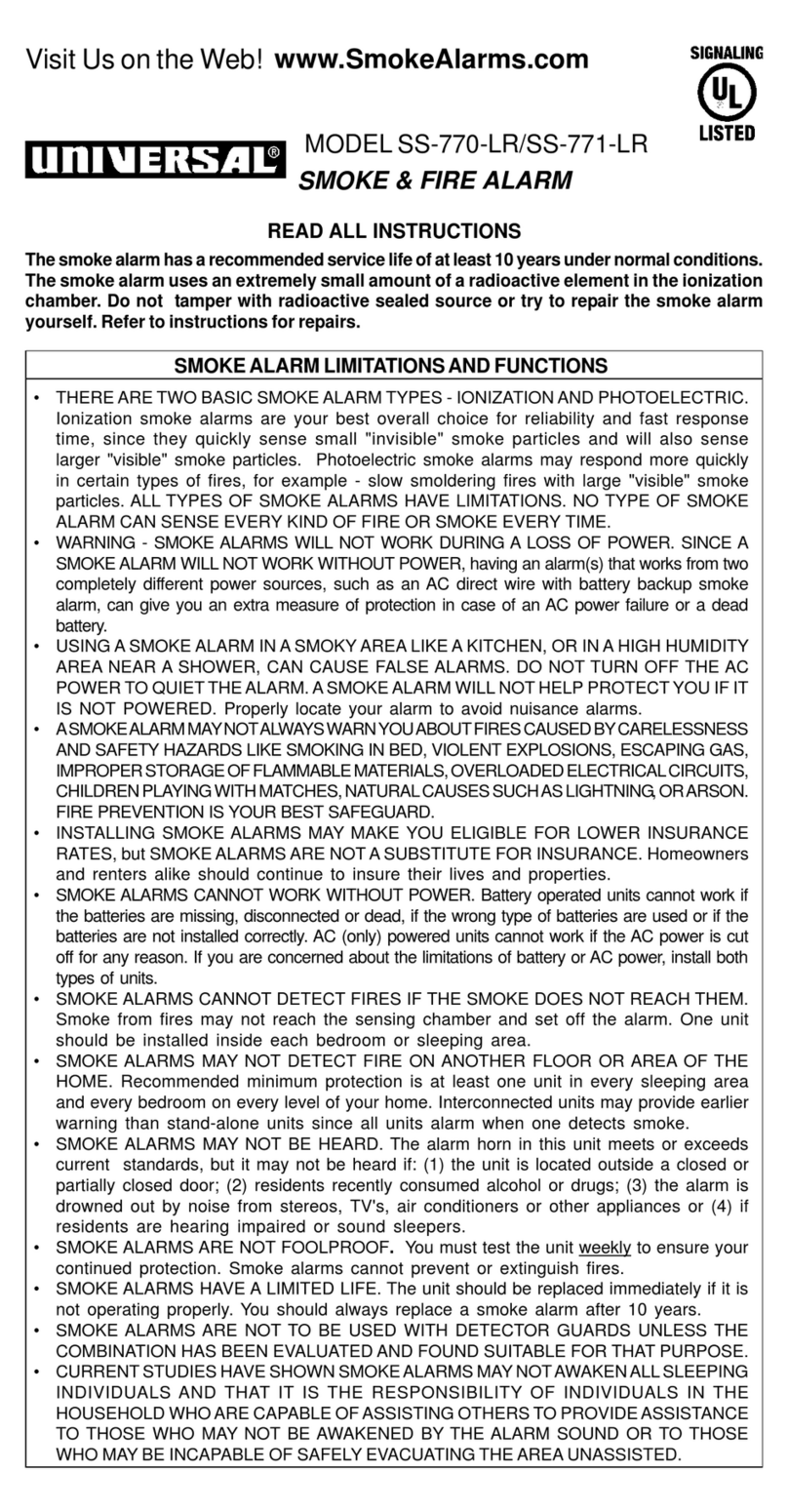
Universal Security Instruments
Universal Security Instruments UNIVERSAL SS-770-LR user manual
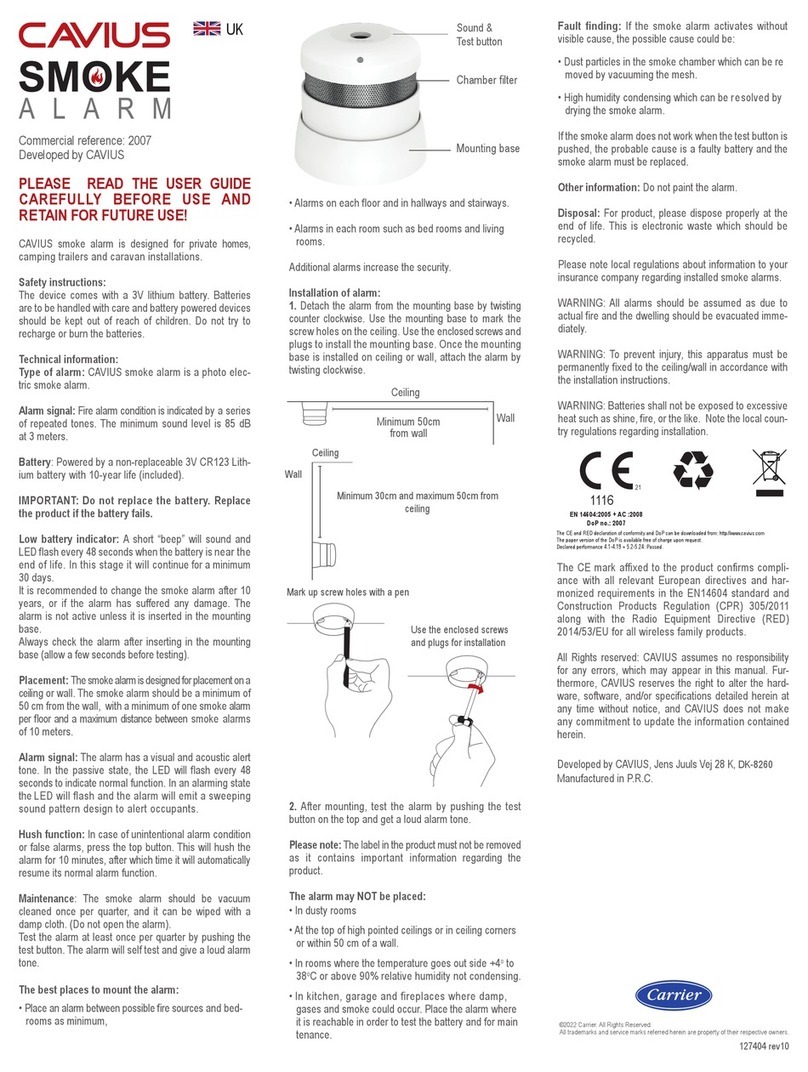
Carrier
Carrier Cavius 2007 user guide
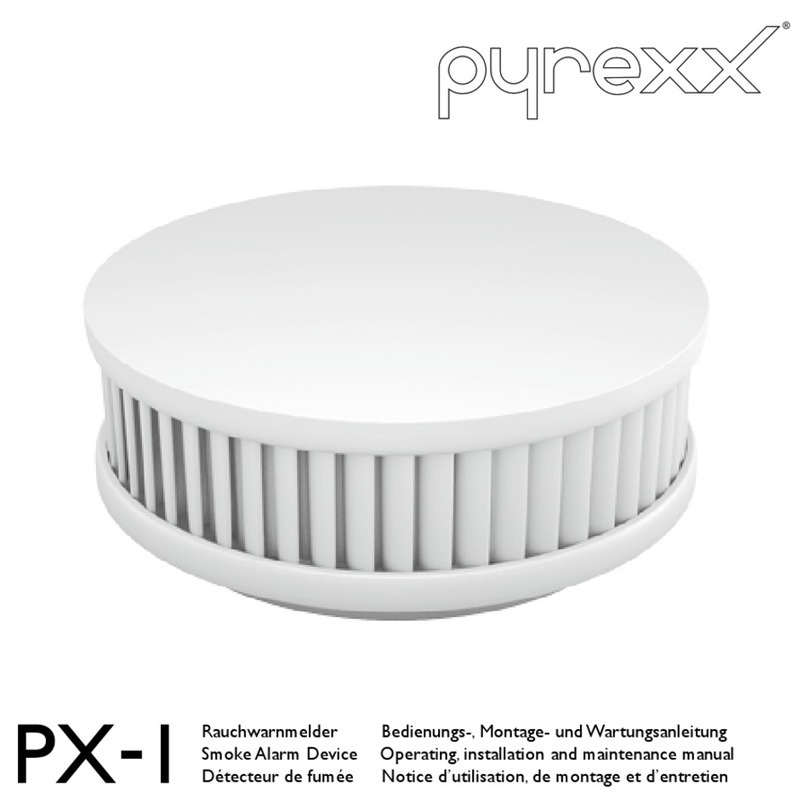
pyrexx
pyrexx PX-1 Operating, installation and maintenance manual
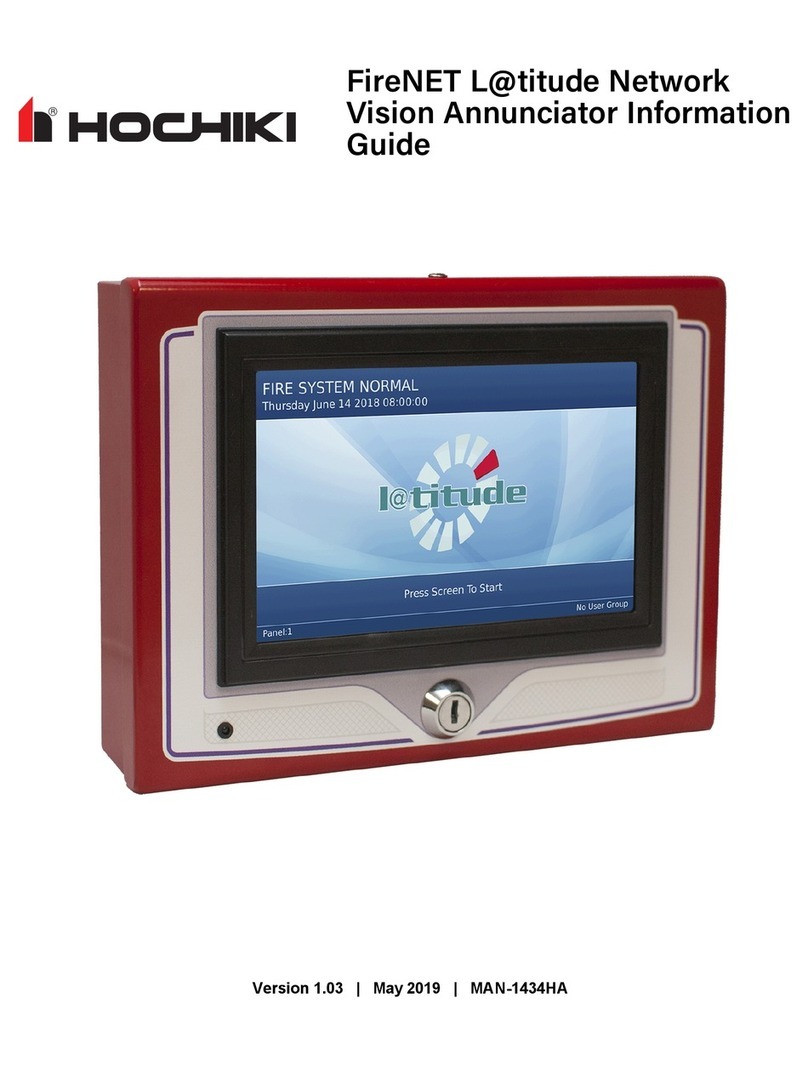
Hochiki
Hochiki FireNET L@titude Series Information guide

x-sense
x-sense SCO6-W user manual

